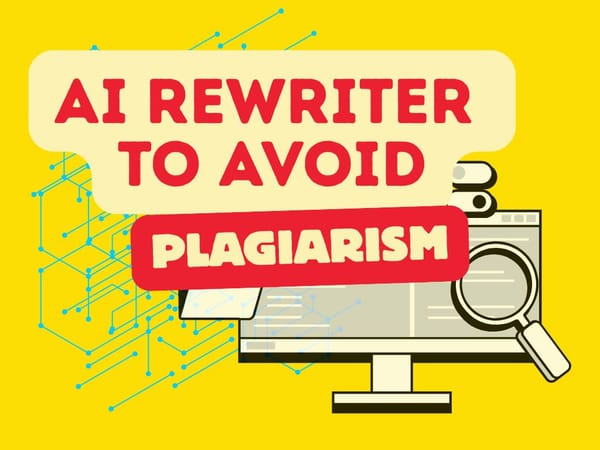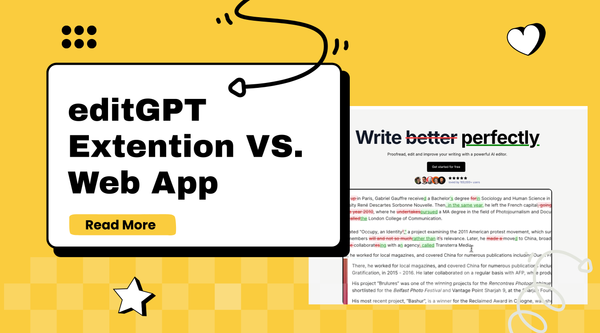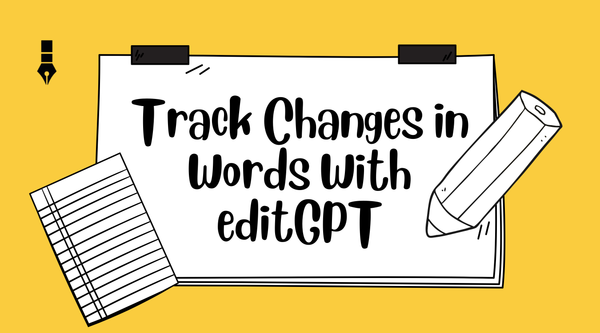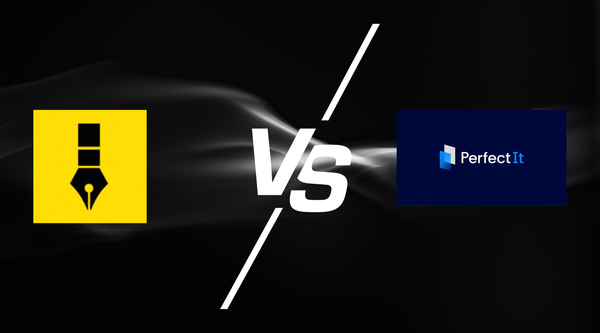editGPT AI Proofreader: Features, Pricing & Who Should Use It.
EditGPT positions itself as more than just another grammar checker, it’s an AI proofreader built to refine clarity, tone, and flow. This guide breaks down its features, pricing, and who will benefit most from using it in 2025.
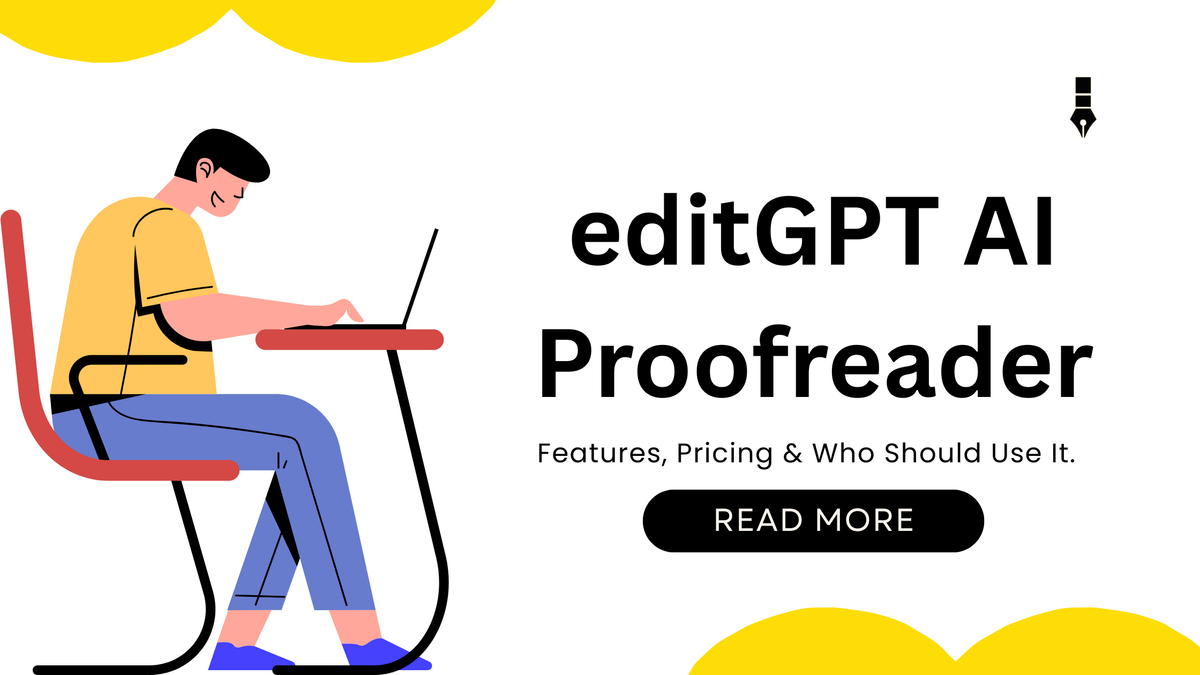
Looking for an AI proofreader that actually improves your writing instead of just fixing typos? You’ve probably come across editGPT, but is it really worth using? Unlike most AI proofreading tools that focus on generating content, editGPT takes a different approach.Think of it as your writing sidekick, helping you sharpen ideas, clean up clarity, tweak tone, and polish drafts, all while keeping your voice intact.
In this post, I’ll walk you through what makes this AI proofreader worth a look: its pricing, standout features, how it compares to other tools, and who’ll get the most out of it.
By the end, you’ll know if editGPT is the upgrade your workflow needs or if you should look elsewhere.
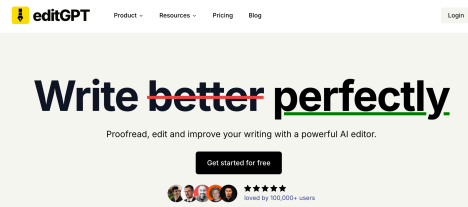
What Is editGPT Ai Proofreader?
editGPT is an AI-powered tool that goes beyond simple proofreading. It helps you polish your writing from top to bottom. Whether you use it as a browser extension inside ChatGPT or in its own editor, it’s built to fine-tune clarity, tone, structure, and consistency.
What it really does
- Real-time ai proofreading with track changes: It highlights grammar, punctuation, and spelling issues, showing edits in a “track changes” style so you can accept or reject them.
- Style, tone, and audience adjustments: You can choose whether to make your writing more formal, casual, concise, or clear.
- Multi-language support: It works in multiple languages, not just English.
- Handles longer content: Works well for essays, reports, and manuscripts, while preserving formatting when used with Word or Google Docs.
- Custom prompts and preferences: You can set how deep or light the edits should be, and save your own style preferences.
What editGPT ai proofreader isn’t
- It won’t write content from scratch.
- It won’t flatten your voice into generic AI text—you still bring the draft, it just helps polish it.
Why editGPT Ai proofreader stands out
- Edits feel more human thanks to context-aware suggestions.
- The track-changes style lets you accept or reject edits with ease.
- You can tailor edits for tone, style, or audience.
- Works smoothly across formats, whether it’s academic, business, or blog writing.
Quick Pros & Cons of editGPT
editGPT Ai Proofreader Pricing: Free, Pro, and Elite Plans
When people look into any tool, pricing is usually the first question. editGPT ai proofreader keeps it simple with three clear tiers, Free, Pro, and Elite, so you can pick what fits your writing habits and budget.
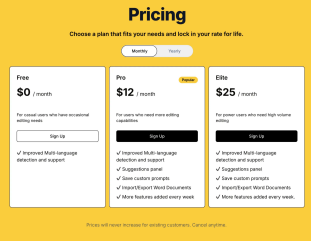
Free Plan — $0/month
For casual users who only need light editing once in a while.
What you get:
- Improved multi-language detection and support
Limitations:
- Limited word count compared to paid tiers
Best for: Students, hobby writers, or anyone who just needs basic proofreading without extra features.
Pro Plan — $12/Month (Most Popular)
- Designed for people who write regularly and need more control.
What you get:
- Improved multi-language detection and support
- Suggestions panel for deeper edits
- Save custom prompts for consistent tone/style
- Import/Export Word documents
- Weekly feature updates
Best for: Bloggers, writers, professionals, and freelancers who want smarter edits and workflow flexibility.
Elite Plan — $25/month
The top tier for heavy users and professionals who deal with a high volume of editing.
What you get:
- Everything in Pro
- Optimized for bulk editing and larger documents
- Full access to advanced updates as they roll out
- Ideal for collaborative publishing workflows
Best for: Power users, editors, publishing teams, or anyone who processes long form or multiple documents daily.
Pricing Comparison Table
Check the official pricing page here
Key Features of editGPT Ai Proofreader
Price matters, sure. But the features are what really tell you if a tool is worth your time. editGPT doesn’t bother with bells and whistles. Instead, it zeroes in on one thing: making your writing shine without stripping away your voice.
Context-Aware Editing
Most grammar checkers are great at catching a stray typo or a missing comma, and then they call it a day. editGPT, on the other hand, actually pays attention to the bigger picture. It looks at how your sentence flows, how it sounds, and whether it’s clear to your reader.
For example:
Before: Our team aims at providing a solution which is not only innovative but also, at the same time, practical in scope.
After (editGPT suggestion): Our team provides a solution that is both innovative and practical.
The meaning stays the same, but the sentence becomes tighter, easier to read, and more professional. This is especially powerful for people who want to sound clear without sounding robotic.
Use case: Professionals writing reports, job seekers editing résumés, or bloggers polishing drafts can all use context-aware edits to make their writing more concise and confident
A graduate student I spoke with said: “Grammarly caught the typos, but editGPT actually made my thesis readable. It was like having an editor who understood my intent.”
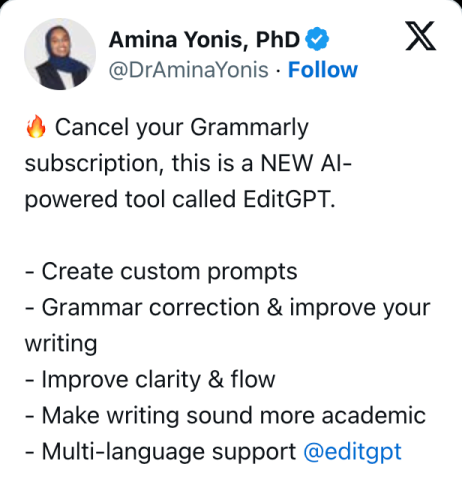
Amina Yonis said “Cancel your Grammarly subscription, this is a NEW Ai powered tool called editGPT ai proofreader.- Create custom prompts- Grammar correction & improve your writing- Improve clarity & flow- Make writing sound more academic- Multi language support @editGPT”
Long-Form Editing
Long documents are where Grammarly and Wordtune often stumble. Feed them a few thousand words and they slow down, scramble formatting, or miss errors that only show up across sections. That gets frustrating fast.
editGPT was made for this kind of work. Essays. Research papers. Deep blog posts. Whole book chapters. It looks beyond single lines and watches how your voice behaves across pages.
If your intro sounds buttoned-up and your conclusion reads like a chatty sign-off, editGPT spots the shift. It points out mismatches and offers fixes that keep the tone consistent. It also protects your formatting and stays quick, even on big files.
Use case: (the long-form kinds of headaches it actually solves):
- Students wrestling with a 5,000-word thesis: tightens transitions, keeps academic tone steady, and helps preserve citations and formatting across chapters.
- Bloggers writing epic guides: polishes headings, keeps terminology consistent, and helps the guide flow so readers stay engaged from top to bottom.
- Authors editing drafts: maintains character voice from chapter to chapter, smooths pacing, and catches style slips that can pull a reader out of the story.
Customization & Prompts
Every writer has a different style — cookie-cutter edits rarely hit the mark. editGPT’s AI proofreader lets you set custom prompts and preferences so the edits actually match your voice.
Set it to formal, citation-ready prose for academic work. Switch to conversational-but-professional for approachable copy; the edits follow the tone you pick.
Teams can save shared prompts to keep a consistent brand voice. For example, a marketing team might lock in a prompt that makes blog posts friendly, confident, and easy to scan.
Use case: marketing teams keeping one voice, freelancers juggling multiple clients, and students who need different tones for essays and presentations.
Tone & Readability Control
Clear writing beats complicated writing every time. That’s why editGPT comes with tools that focus on readability, helping you cut through clutter and keep your message sharp.
Got a draft packed with jargon or sentences that run on forever? editGPT breaks it down into shorter, smoother lines that are easier to follow. Your point stays the same—you just end up with text people actually want to read.
Use case: Handy for bloggers who want articles that flow, businesses fine-tuning landing pages that hold attention, or anyone who needs higher readability scores without losing their own style.
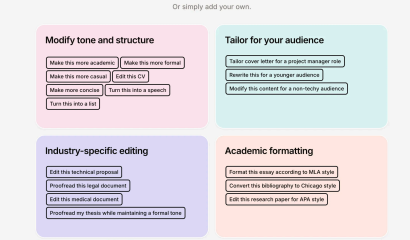
Accuracy vs Simplicity
A big gripe with most AI editors is that they sand down your writing until it feels like cardboard. Your voice gets lost, and suddenly everything sounds like it came from a manual.
editGPT takes a different approach. It only steps in when a tweak will actually make your sentence clearer or easier to read. The goal isn’t to rewrite you. It’s to help you sound like your best self on the page.
For example, if you write, “I kinda think this idea might work,” editGPT might suggest, “I think this idea could work.” Same casual vibe, just a little tidier.
Use case: Perfect for writers who want polish without losing personality, especially bloggers, essayists, or any creator with a style worth keeping.
Integrations & Compatibility
A writing tool isn’t much help if it only works in one corner of the internet. That’s why editGPT was built to slide right into the platforms you already use.
It runs as a browser extension in ChatGPT (handy for polishing AI drafts), plugs into Word and Google Docs without messing up your formatting, and doubles as a web app for writing directly.
There’s even a Chrome extension so you can tidy up text anywhere: emails, CMS dashboards, you name it.
And the best part?
It’s not standing still. New features roll out regularly, so the tool keeps getting smarter and more versatile over time.
Use case: Great for students polishing essays in Google Docs, professionals editing reports in Word, or creators publishing straight from their CMS.
Wrapping Up the Features
editGPT isn’t about one “killer feature.” It’s about how the whole package works together. You get edits that actually make sense in context, support for big writing projects without slowing down, tone controls that keep your voice intact, and integrations that slide right into the tools you’re already using.
All together, it feels less like another grammar tool and more like something built for actual writers.
What Users & Reviewers Are Saying About editGPT
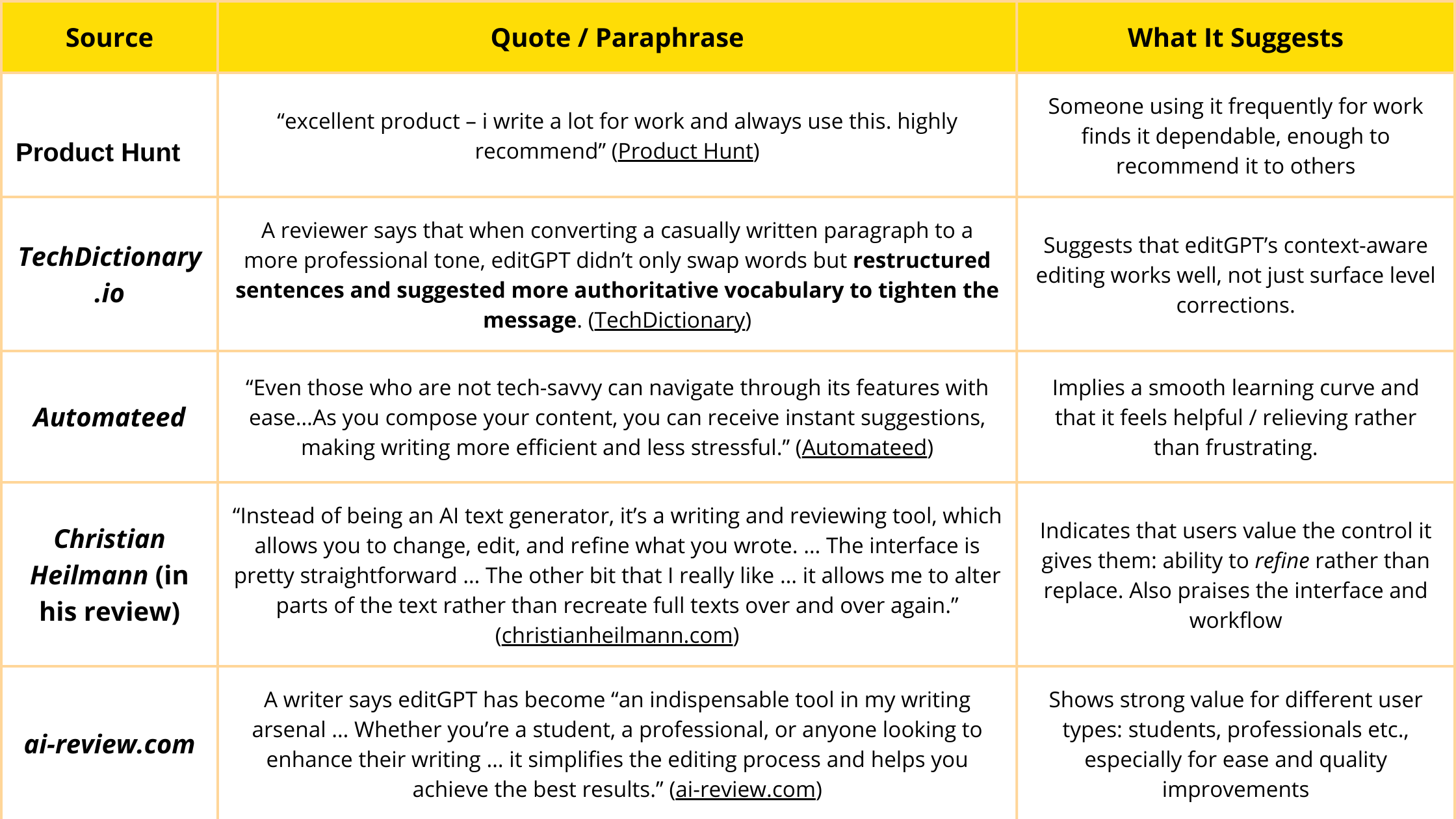
editGPT Ai Proofreader vs Free Alternatives
If you want cleaner writing without opening your wallet, editGPT Free holds its own against big names like Grammarly Free and Wordtune Free. Here’s a quick breakdown of how they compare:
How The Free Versions Compare
editGPT Free
Goes beyond the usual grammar-and-spellcheck routine. You still get clarity tweaks, tone adjustments, and sentence rewrites right out of the gate. One reviewer even said the free plan feels “closer to premium proofreading” than most other options.
Grammarly Free
Solid for grammar, punctuation, and spelling. Perfect for catching the little slip-ups. But if you want tone suggestions, advanced clarity edits, plagiarism checks, or full rewrites, those are tucked behind the paid plan.
Wordtune Free
Focused more on rewriting and paraphrasing individual sentences. Offers
alternate ways to say things, helping with style, but with limits.
Fewer features for grammar checking compared to Grammarly; less comprehensive in catching deeper style or context issues without upgrading.
Relative Strengths of editGPT Free
Better “polish” for free: Users report that editGPT Free gives suggestions that improve tone and clarity more consistently than some free versions of
Grammarly or Wordtune.
Sentence rewrite + clarity even in free tier: editGPT makes it easier to go beyond error-correction to make sentences clearer, smoother, more reader friendly
Takeaway
If I had to pick:
editGPT Free is the one I’d go for if you want more than the basics. It fixes grammar and spelling, but also gives you clarity, tone, and style tweaks. Basically the kind of features you’d usually have to pay for elsewhere.
Grammarly Free works great if all you care about is grammar and spelling, but don’t expect it to polish up your flow or tone.
Wordtune Free is fun for sentence rewrites and playing around with phrasing, though the daily limit can be a bit of a buzzkill.

editGPT vs Paid Competitors
Premium editing tools are everywhere, but most come with gaps that leave writers frustrated. editGPT fills those gaps by offering advanced proofreading, clarity, and tone control at a fraction of the hassle. Let’s see how it stacks up against the “big names.”
editGPT vs Grammarly Premium
Grammarly Premium is mostly known for its grammar and spelling corrections. It also includes plagiarism detection, but that’s really its one extra edge.
The problem is that Grammarly often feels mechanical, it fixes mistakes but doesn’t always improve clarity or flow. Its tone suggestions are surface-level and don’t adjust your writing in a meaningful way.
editGPT ai proofreader does everything Grammarly does for grammar and spelling, but goes further with context-aware editing. It makes your sentences sharper, adapts your tone for your audience, and even optimizes for SEO readability. With editGPT, you don’t just get “error-free” writing, you get writing that actually connects with readers.
Who should choose which?
If plagiarism detection is critical to your work, Grammarly Premium still has the upper hand. But if you care more about making your writing clear, polished, and reader-friendly, without paying extra for advanced tone tools, editGPT Pro gives you that at a better value.
Related reading: 10 Best Grammarly Alternatives in 2025
editGPT vs PerfectIt
PerfectIt has its fans, especially in worlds where rules matter most: editors, lawyers, researchers. It’s brilliant at spotting the tiny stuff, like a stray capitalization or a reference that doesn’t match. If your job depends on catching those details, it’s a lifesaver.
Outside that bubble though, it feels a bit… rigid.
It won’t help you smooth clunky sentences, adjust tone, or make your writing flow better. That’s where editGPT comes in. It bends with whatever you’re writing—light and chatty for blogs, polished for business reports, or crisp for exec summaries.
So if you need strict consistency, PerfectIt is solid. But if you need an editor you’ll actually use every day, editGPT’s the one that fits.
Read more: PerfectIt vs EditGPT
editGPT vs ProWritingAid
ProWritingAid does a lot. It checks grammar, points out style issues, measures readability, even breaks down the structure of your writing.
That’s handy if you like digging into reports. The downside? It can be slow and a little overwhelming when you just want quick edits.
editGPT is more straightforward.
It looks at your text in context and gives you fixes right where you need them—no long reports, no extra noise. You get suggestions for clarity and flow, and you can move on.
If you’re the kind of writer who loves analyzing every detail, ProWritingAid will probably feel right at home. But if you’d rather keep things fast and focused, editGPT makes the process a lot easier.
Read more: ProWritingAid vs EditGPT
Bottom Line
Paid tools all bring something to the table. Grammarly Premium offers plagiarism detection, PerfectIt enforces strict style guides, and ProWritingAid provides deep writing analytics. But none combine speed, clarity, context, and readability the way editGPT does. For most professionals, students, and creators, that balance makes editGPT the smarter choice.
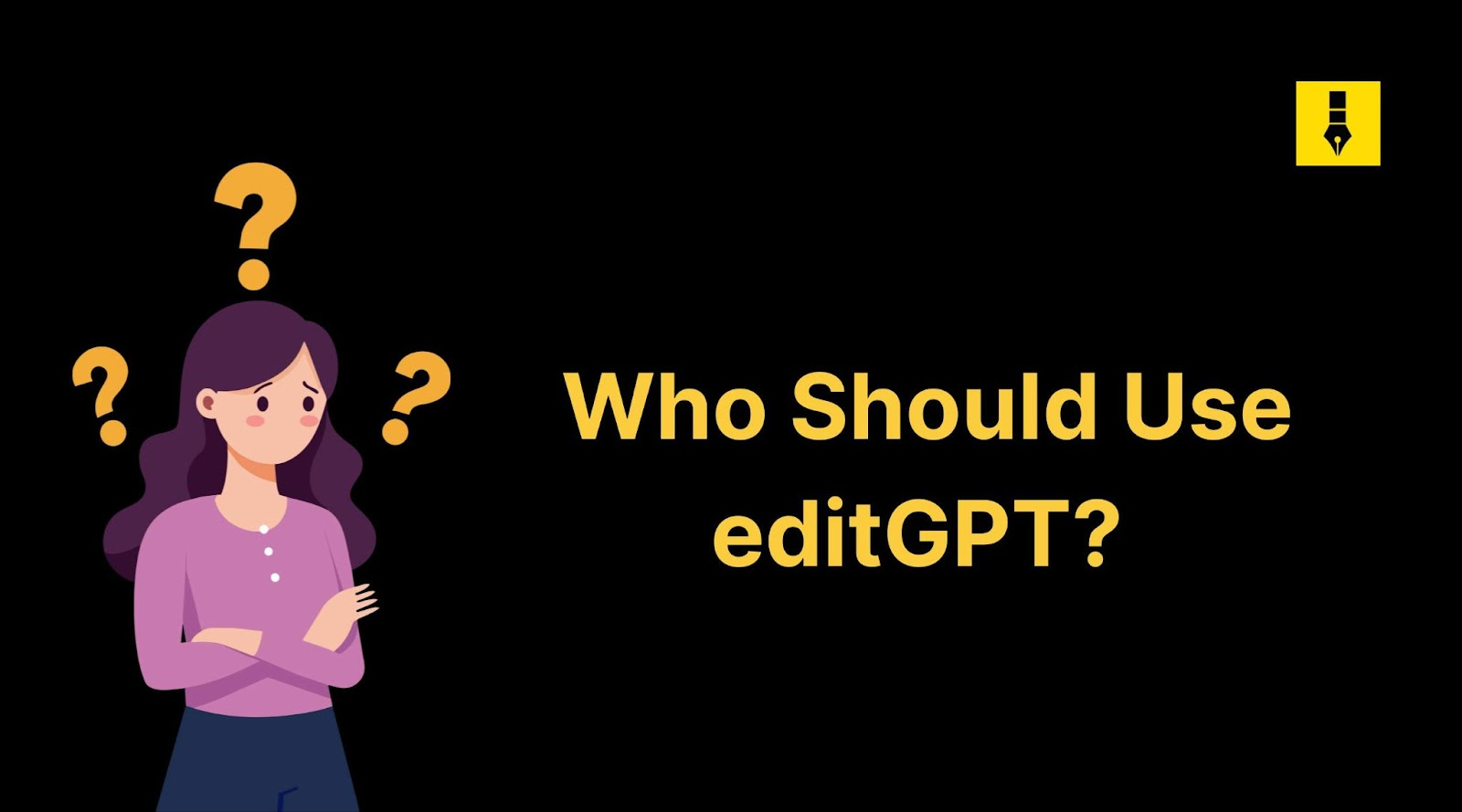
Who Should Use editGPT?
Honestly, just about anyone who writes. But here’s where it really earns its keep:
Students
Working on essays, dissertations, or research papers? editGPT cleans things up so your arguments come across clearly without changing what you meant. Professors care about flow just as much as grammar.
Content Creators & Bloggers
Long sentences and jargon don’t play well online. editGPT helps you cut through the clutter so your posts are sharper, easier to skim, and better for SEO.
Professionals
Everyday writing - emails, reports, proposals - adds up. editGPT makes those sound polished and confident, without you spending forever second-guessing every word.
Authors & Researchers
Big projects like manuscripts or journal articles need consistency. editGPT smooths out tone, untangles tricky sections, and keeps the whole thing clear from start to finish.
Teams & Businesses
With the Elite plan, everyone stays on the same page. Shared prompts lock in your brand’s voice, and bulk editing shaves time off publishing workflows.
Is editGPTWorth It? (Final Verdict)
The short answer is yes, if you need more than just basic proofreading.
It’s worth it for professionals who want clear, polished communication without wasting time. It’s worth it for students and researchers who need their ideas presented in the best possible light. And it’s worth it for businesses and teams that need consistent, high-quality writing across documents and platforms.
Compared to the cost of hiring an editor, the value is undeniable. For as little as $12 a month, editGPT gives you context-aware editing, tone control, and clarity improvements that feel close to human proofreading.
Try editGPT Free, upgrade when ready. Check pricing here
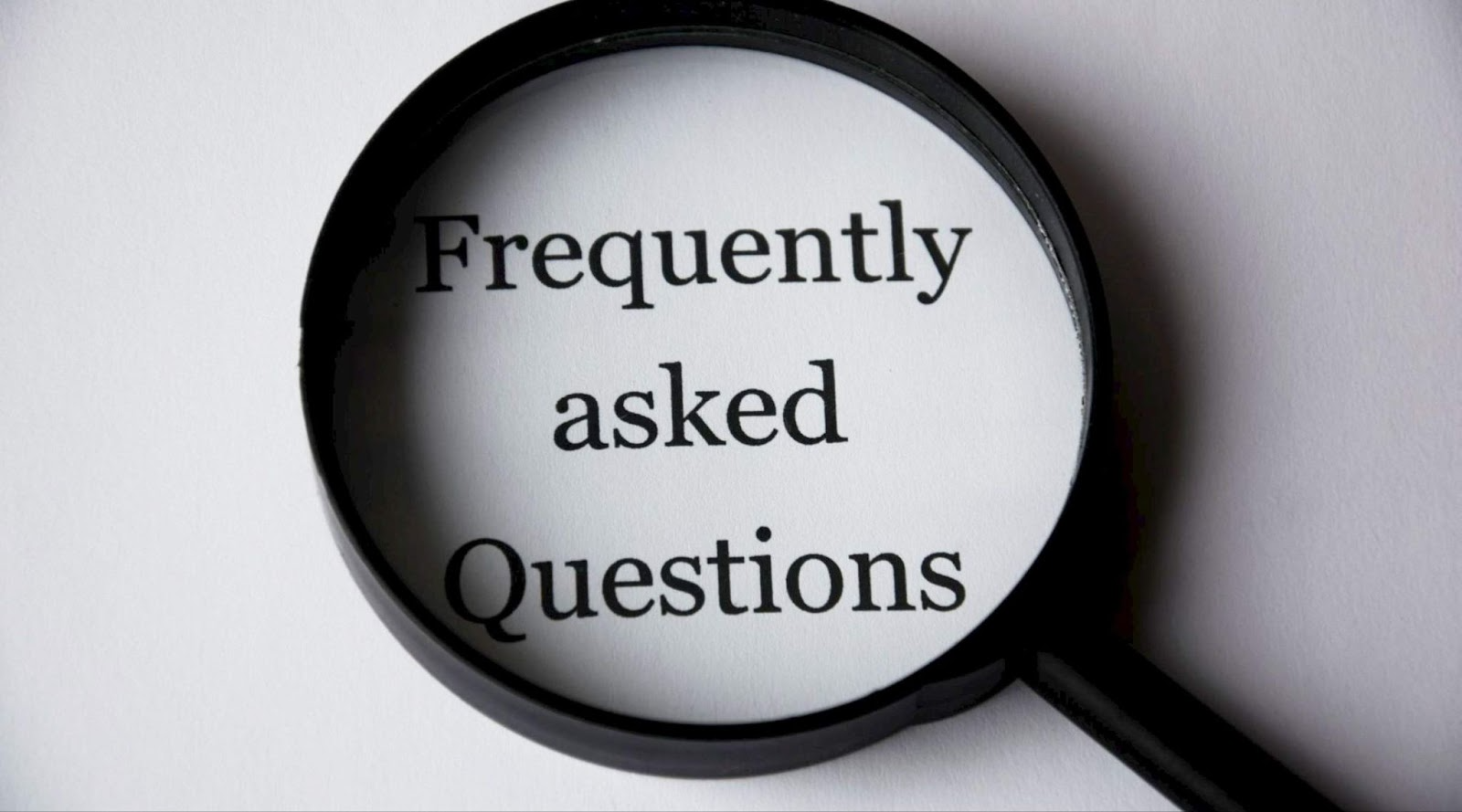
FAQs
Is editGPT free?
Yes. editGPT has a free plan that includes multi-language proofreading and basic editing. The free tier is limited to 10,000 words per month with a 600-word cap per request.
How much does editGPT Pro/Elite cost?
Pro costs $12 per month and unlocks features like tone control, custom prompts, Word import/export, and weekly updates. Elite costs $25 per month and adds bulk editing and advanced features for teams and heavy writers.
Is editGPT better than Grammarly?
Yes, for most users. Grammarly focuses heavily on grammar and spelling, while editGPT goes further by improving clarity, readability, and tone. If plagiarism detection is your main priority, Grammarly Premium has that feature, but for overall writing polish, editGPT offers more value.
Can editGPT replace a human editor?
Not entirely. A human editor brings creativity and nuanced judgment. However, editGPT ai proofreader gets impressively close for everyday writing tasks, academic work, and business communication. It can save hours before you even need a final human review.
Who should use editGPT?
Students, professionals, bloggers, authors, researchers, and businesses benefit most. It’s designed for anyone who needs reliable proofreading plus improvements in flow, style, and tone.
Start with the free version and see if editGPT fits your workflow. Upgrade to Pro or Elite for advanced editing power. Try editGPT here
Recommended Reading
- Video review: This AI Text Editing Tool Is FLAWLESS!
- Best AI Proofreader Tools of 2025 (Tested for Accuracy, Speed & Tone)
- editGPT vs Grammarly vs Quillbot: Which Writing Tool is Best?
- The Best AI Proofreaders That Actually Work (Free & Paid)
- Try editGPT
- Review: Wordtune Editor vs editGPT
- Review: Grammarly vs editGPT
- Review: ProWritingAid vs editGPT
- Review: Hemingway Editor vs editGPT
- Review: 10 Best Grammarly Alternatives for Writers in 2025/2026
- Review: editGPT vs Trinka AI: Which is the best Grammarly alternative?
- Best AI Tools for College Essay Editing in 2025
- What is the best AI Proofreader?
- Best AI Proofreader Tools of 2025 (Tested for Accuracy, Speed & Tone)
